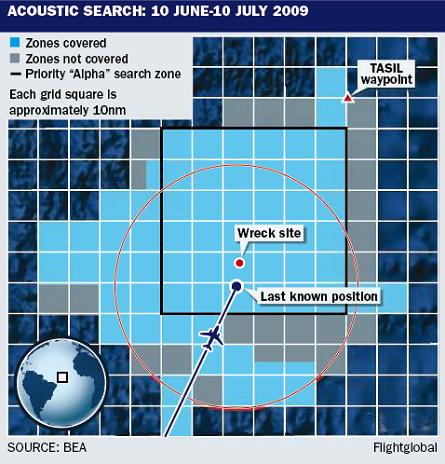French investigators are to re-examine acoustic data from the initial search for the crashed Air France flight AF447 to determine whether the Airbus A330's flight recorders could have been located earlier.
On day 700 of the hunt, 1 May, the long-sought flight data recorder's memory cylinder was located and raised on board the recovery vessel Ile de Sein, despatched to the crash site after the wreckage of the twinjet was discovered on 3 April. It was followed, 34h later, by retrieval of the cockpit voice recorder.
France's BEA investigation agency expects to receive the devices by the end of next week, when it will begin the task of assessing whether they contain any readable information.
The BEA also wants to understand whether it missed an opportunity to pinpoint AF447 during the 31-day acoustic hunt for the recorders' locator beacons, launched days after the accident on 1 June 2009.
 |
|---|
"The area where the wreckage was found had been explored without detecting the [beacon echoes]," said BEA director Jean-Paul Troadec. "The reasons for this non-detection will now be sought."
The flight data recorder was damaged, with its memory cylinder separated from the interface electronics, and did not have its beacon attached.
However, the BEA said that the cockpit voice recorder's beacon was retrieved and will undergo analysis to see if it was functional. The BEA added that the beacon manufacturer put the transmission duration at around 40 days.
The acoustic search started on 10 June 2009 and covered around 22,000km2 (8,500 miles2). This amounted to 74% of the initial target area surrounding the last known position of the aircraft, and crucially included the place where AF447 was eventually found.
"When we compared [our search] to what we did in the past, we noticed we were searching this area before," said the BEA.
"The issue is to know whether the pingers stopped because they were out of order, due to the impact - we need to check that - or if we had not searched properly with the equipment."
The agency pointed out that the wreck was found at 3,900m (12,800ft) and the exploration marked the "first time we've searched at such a depth", and added that the BEA will assess whether the equipment deployed in the acoustic phase was adequate for the task.
While a nuclear submarine was used during the search, its sonar interceptor was not originally designed to pick up the 37.5kHz beacon signal. Lower-frequency transmissions, around 8.5-9.5kHz, would have improved the chances of this, said the BEA. But improved sensor settings enabled the maximum distance for detection to increase from 2,000m to 3,200m during the last 10 days of the acoustic search.
Although the beacon and memory cylinder of the data recorder separated from the device's chassis, manufacturer Honeywell said it is not looking at amending the design, pointing out that it meets regulatory and OEM requirements.
Source: Flight International



















